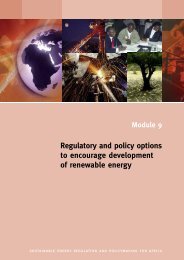Increasing access to energy services in rural areas - REEEP ...
Increasing access to energy services in rural areas - REEEP ...
Increasing access to energy services in rural areas - REEEP ...
Create successful ePaper yourself
Turn your PDF publications into a flip-book with our unique Google optimized e-Paper software.
MODULE 10: INCREASING ACCESS TO ENERGY SERVICES IN RURAL AREAS<br />
page 10.29<br />
7. DIFFERENT MODELS FOR INCREASING<br />
ENERGY SERVICES IN RURAL AREAS<br />
Although some develop<strong>in</strong>g countries long ago recognized the importance of<br />
<strong>energy</strong> <strong>in</strong> <strong>rural</strong> development, it was only follow<strong>in</strong>g the so-called <strong>energy</strong> crisis <strong>in</strong><br />
the early 1970s that <strong>rural</strong> development policy-makers began <strong>to</strong> show greater concern<br />
for the <strong>energy</strong> constra<strong>in</strong>ts fac<strong>in</strong>g them.<br />
As the world suddenly entered an era of ris<strong>in</strong>g <strong>energy</strong> prices and unstable petroleum-based<br />
fuel supplies, these fac<strong>to</strong>rs threatened <strong>to</strong> accelerate the perceived<br />
gradual environmental depletion associated with <strong>rural</strong> people’s heavy reliance on<br />
fuel-wood and agricultural residues <strong>to</strong> meet their basic <strong>energy</strong> needs. As supplies<br />
of petroleum-based fuels became more costly and unreliable, it was believed that<br />
people would have <strong>to</strong> switch back <strong>to</strong> traditional or nature <strong>energy</strong> sources.<br />
Therefore the option <strong>in</strong> the most develop<strong>in</strong>g countries became <strong>to</strong> <strong>in</strong>crease <strong>energy</strong><br />
<strong>services</strong> by us<strong>in</strong>g different bus<strong>in</strong>ess models.<br />
7.1. Market-based models<br />
There are very limited successful s<strong>to</strong>ries for <strong>in</strong>creas<strong>in</strong>g <strong>energy</strong> <strong>services</strong> <strong>in</strong> a susta<strong>in</strong>able<br />
fashion <strong>to</strong> <strong>rural</strong> <strong>areas</strong> us<strong>in</strong>g a market-based model, due <strong>to</strong> the distributed<br />
service and limited profit on <strong>in</strong>vestment <strong>in</strong> this area. However, <strong>in</strong>ternational<br />
aid agencies have developed several market based bus<strong>in</strong>ess models <strong>to</strong> <strong>in</strong>crease<br />
<strong>energy</strong> <strong>access</strong> <strong>to</strong> <strong>rural</strong> <strong>areas</strong>. The general implementational flow of most marketbased<br />
models is shown <strong>in</strong> figure III.<br />
Figure III.<br />
Implementational flow of market based models<br />
Fund from<br />
<strong>in</strong>ternational<br />
aid agencies<br />
Bus<strong>in</strong>ess<br />
service<br />
companies<br />
Local <strong>energy</strong><br />
service<br />
companies<br />
Rural users<br />
International or<br />
local commercial<br />
banks or <strong>in</strong>ves<strong>to</strong>rs










